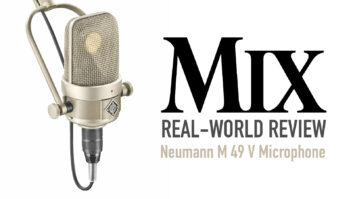
The TLM 102 features a new capsule, low noise and handles up to 144dB SPL.
On first sight of the new Neumann TLM 102, one might ask, “Honey, who shrunk the TLM 103?” Indeed, the TLM 102 looks like a miniaturized TLM 103, the mic that made quite a splash on its introduction in 1998 as the most affordable offering ever from Neumann. The TLM 102 now holds that distinction, employing a new capsule engineered for use on a wide variety of instruments, at SPLs up to 144 dB (less than 0.5-percent THD). The TLM 102 has a cardioid polar pattern and a slight presence peak that starts around 6 kHz. The mic ships in a no-frills box with an SG 2 stand-mount. Neumann’s EA 1 shock-mount may also be used with the TLM 102.
Solid Performer
I first tried the TLM 102 to record acoustic guitar. Aimed at where the neck meets the body on a Martin D-15, the TLM 102 sounded gorgeous, providing a full, natural sound with a present top end that was not hyped or etched. The TLM 102 manual says that the mic’s response extends below 20 Hz, making it sensitive to wind or structure-borne noise. This definitely proved to be the case; using the standard mount, the mic easily picked up foot-tapping sounds through the mic stand. (Using a shock-mount alleviated this issue.) The extended response can also exaggerate the TLM 102’s proximity effect: Place the mic near the sound hole, and the result can be very boomy. Unfortunately, the TLM 102 doesn’t offer it, but a highpass filter should be considered mandatory, either at the preamp or in the DAW.
When used on male vocals, the TLM 102 dials up some mojo in the low-mids, giving the voice a nice, thick timbre that stands up in the mix. Interestingly, this characteristic does not show up on the frequency response chart, so it’s probably a product of proximity effect, which can be controlled by backing off the singer to a distance of around 10 inches. On a female vocal, these qualities gave the voice a smoky, “retro” quality more like I’d expect from a ribbon microphone—intimate and detailed, perfect for a jazz singer but the opposite of what we hear on countless pop records from female singer/songwriters these days—i.e., bright and thin.
On a Yamaha grand piano, a pair of TLM 102s produced a rock-solid stereo image. Tone was rather thick in the low-mids for this particular instrument, and would probably be more appropriate for a solo piano recording. Fitting it into a mix required pulling out a few dB at 150 to 200 Hz, and the mics’ low-frequency extension captured quite a bit of pedal noise.
I also used the pair in front of a drum kit for room mics. Here they delivered a healthy knock from the kick and a very uncolored snare. Balance of the kit was “correct,” and the cymbals were not overly bright. When I moved the TLM 102 in close on a snare drum (approximately three inches from the rim, pointing toward the center of the head), the result was excellent. It nailed the “thwack” of the drum without being thin or obnoxious. Leakage from the hi-hat was well under control, though there was a considerable amount of spill from the kick. The TLM 102 seems to accept more off-axis spill of low-frequency material than other mics I’ve used. If you look at the TLM 102’s polar response, it does, in fact, become less directional as frequency decreases (which is not unusual for a cardioid mic).
Quiet and Clean
I’m happy to say that the TLM 102 does not conform to the recent trend of voicing condenser microphones with a built-in “smile” EQ. It’s not perfect for everything (what microphone is?), but there’s definitely something nice going on in the low-mids that really flatters vocals and certain acoustic instruments. One last thing worth mentioning is that the TLM 102 is very quiet—almost as quiet as the TLM 103—a quality that increases its versatility. The TLM 102 opens a new world to project recording, offering Neumann quality and sound at a reasonable price.
Steve La Cerra is a New York–based live sound engineer.

Click on the Product Summary box to view the Neumann TLM 102 product page.






